Mix the paints in cups with water.
How To Paint A Koi Fish: A Step By Step Guide and Video
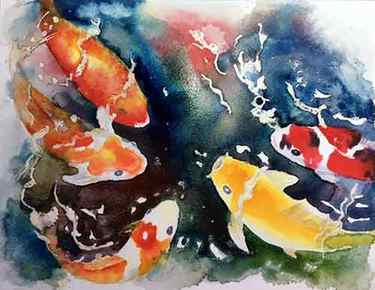




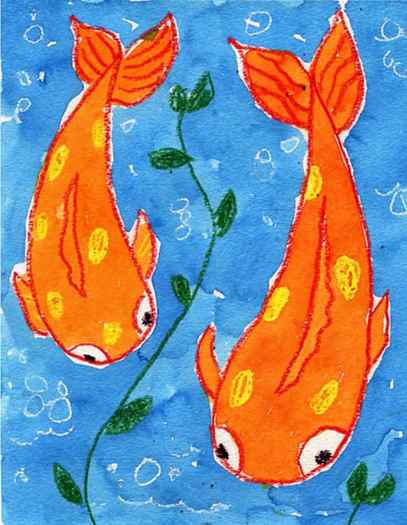
Koi Fish Painting Video Tutorial
A tutorial for learning how to paint a Koi Fish has a lot to offer young students. The view from overhead keeps the shapes really simple and graceful. As a watercolor resist, there’s the fun of adding white crayon lines for bubbles (always fun when they appear!) and the blue and orange combination just make theWfish pop off the page.
Koi fish are an ornamental species that descend from the carp family. Chinese were farming carp in rice paddies, a practice that traveled to Japan. The Japanese noticed odd color variations in some of the carp and bred them, creating the koi species. Koi used to only be found in red, white, black and blue, but have since been bred in different combinations of all the colors in the rainbow. Today, the most popular tend to be the lovely orange, white and yellow fish.
Getting Started with Drawing Guides
The best way to get students off to a good start to any drawing lesson is to show them how to use guides as a reference point.
You may have noticed that all of the tutorials on this site have a dashed line running through the center of each step, both in the horizontal and vertical direction. If students make their own centered lines on their own paper, before drawing, they will have an easy reference to follow.
For instance, as seen in Step 1 below, the teardrop shape needs to be sitting on the left half of the paper, and closer to the top than the bottom. It’s important to sketch that shape big enough and high enough on the sheet of paper so that there’s room for the larger fish on the right. When beginners get their drawing off to a good start, there’s a better chance of them feeling successful by the time they are done.
So how do students get their lines on their paper? Folding is not recommended for watercolors because it will leave creases, not to mention make the thick paper harder to work with. Instead, it’s recommended that teachers of young students find a quick way to add the lines in pencil before hand. Older ones that can measure and draw on their own can make the lines themselves. Just be sure to emphasis these lines must be drawn lightly, so they can get erased before painting.
painting koi fish
Start the painting with yellow koi who is the focal point of the painting.
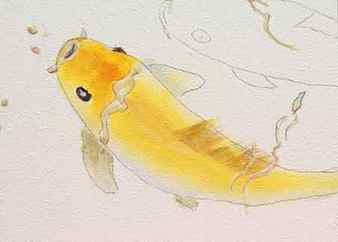
Start painting the focal fish.
We bring attention to a focal point by using warm verses cool colors.
We also use contrasting values.
He is painted with New Gamboge. Add a bit of blue to grey down his fins.
The eyes and mouth are a combination of red and blue that makes a black.
Next is the side-kick of the yellow koi fish. This koi is a bit smaller, so it will look deeper in the water.
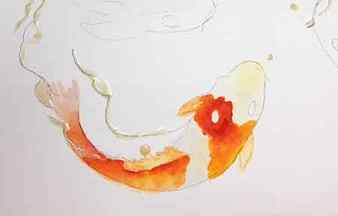
The colors flow to make orange.
Paint yellow on what will be the orange parts of the koi fish.
While it was still wet, drop in some Quinacridone Red. They mingled together to create orange.
Lightly used some yellow to indicated warmth on the white areas of the fish.
That’s the beauty of painting koi fish with watercolor. The watercolors flow together so beautifully.
Next is the body guard for the yellow koi fish. He looks tough, don’t you think?
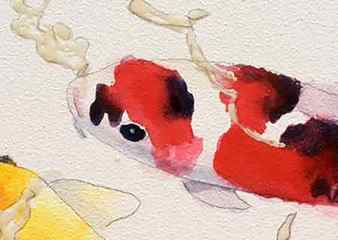
Paint the red and black / leave the white dry.
Wet the colored areas of the fish with clear water and leave the white areas dry.
Paint the red areas with Winsor Red. Quinacridone Red didn’t give a very bright red. Use whatever red you prefer. The cadmium reds or their replacement (Winsor Red) give the most saturated red colors.
While the red was still wet, add some black spots. The colors softly mingle together. (Mix the red and blue for the black.)
Oh, the beauty of painting watercolor!
We can practice pouring watercolor with this koi fish. (How to pour is in the next section.)
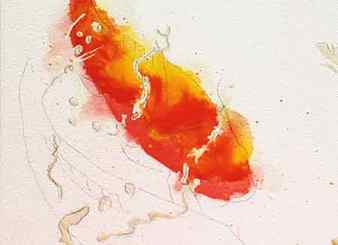
Experiment with the top fish.
Pour yellow on one side.
Then pour red on the opposite side of the fish. Let the two colors to mingle together.
They mingled, but they ran outside of the area of the fish because the mix had too much water.
The dark background will cover the runs outside of the fish’s body.
That’s part of the challenge of pouring with watercolor.
Next – the background
The major painting is done on the koi fish. Let them dry.
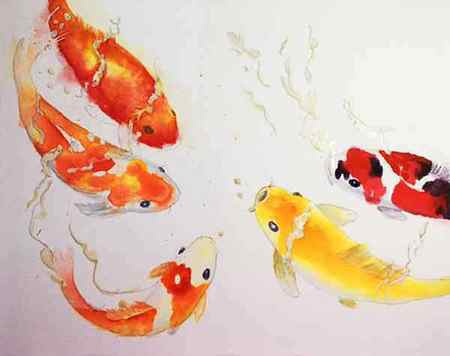
Ready to do the background
We will detail the koi more after the background is finished.
When the background is done, we will be better able to see the colors and values. Then we can use them to our advantage.
pouring watercolor for the background
Pouring is a fun part of painting these watercolor koi.
Mix the paints in cups with water.
Put about a quarter inch of each color into separate containers. The small cups used for dipping crab in butter work great.
Add about a tablespoon of water.
Stir thoroughly to dissolve all the paint.
start pouring the watercolors
- Be sure the fish are dry!
- Keep the painting support level. We are better able to control the colors and keep them out of the koi on a level surface.
I started with the blue in the upper right. Then I put some red on the left. The top edges of the blue and red were spritzed to make them softly move out into the white.
Keep pouring the three colors around the koi. Use your artistic license and choose what looks good to your preferences.
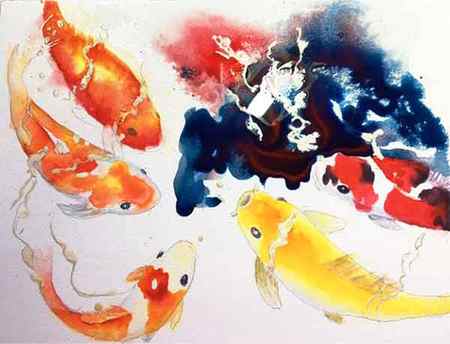
Start pouring paint around the fish.
The unpredictable movement of the colors is a joy of pouring watercolors!
let the paint dry
When you are satisfied with the results, let the koi fish painting dry overnight.
The colors between the lower left koi look brown. Oh-oh, I realize what I did. I broke one of my own rules.
I mixed Winsor Red. It is not a transparent color. It doesn’t mix well with other colors. So I got brown instead of a purple. But actually it makes a warm background for the warm fish.
The background around the yellow focal fish is cool. The contrast brings attention to the focal koi.
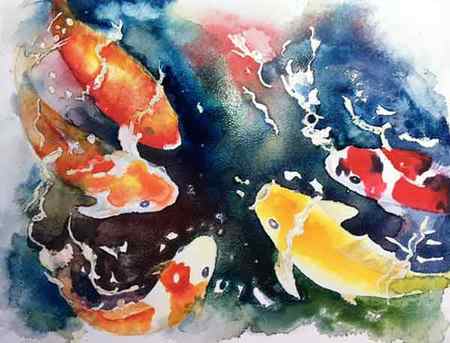
The pouring is finished. Let it dry.
detailing the watercolor koi
Look over each koi. Make any necessary adjustments that catch our eye.
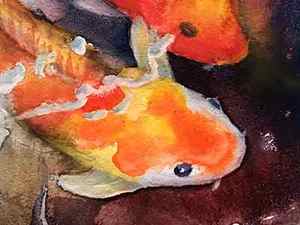
Use a damp brush to soften the edges of the koi.
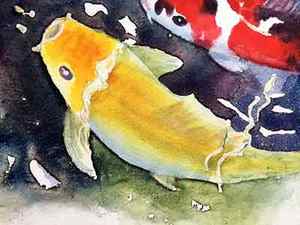
Leave the hard edges on the focal koi to make him stand out.
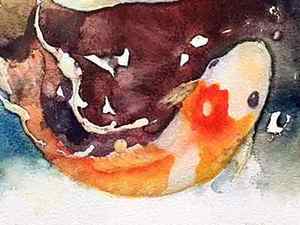
Apply a thin wash of blue around each koi to set them into the water.
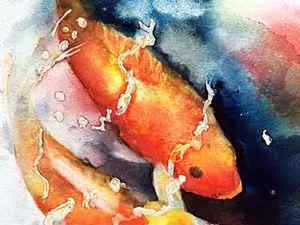
If the poured watercolor went over the fins, clean them with a stiff damp brush.
Make sure the painting is dry, then remove the masking.
When I was first learning how to paint watercolors, I made the mistake of removing masking from damp paint.
What a mess! The masking picked up paint. I got paint on my fingers and touched it into areas where it didn’t belong. A lesson well learned.





